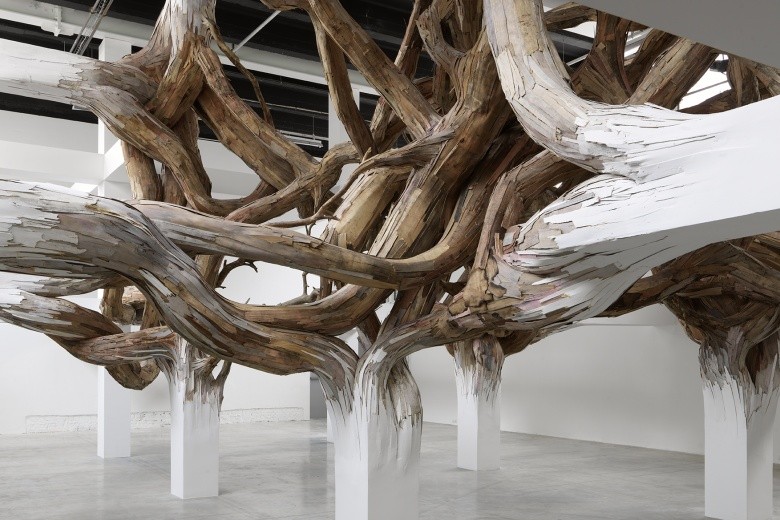Henrique Oliveira
21 Jun - 08 Sep 2013
HENRIQUE OLIVEIRA
Baitogogo
21 June - 8 September 2013
Creating a spectacular and invasive Gordian Knot, Henrique Oliveira plays with Palais de Tokyo’s architecture, allowing a work that combines the vegetal and the organic to emerge. The building itself becomes the womb that produces this volume of “tapumes” wood, a material used in Brazilian towns to construct the wooden palisades that surround construction sites.
In the form of paintings, sculptures or installations, the hybrid art of Henrique Oliveira (b. 1973, lives and works in São Paulo) evokes both the urban and the vegetable, the organic and the structural, as well as art and science, through compositions in which the unexpected generates a universe tinted with the fantastic.
Graduating from the University of São Paulo in 1997, the artist explores fluidity, the combination and color of materials, which endows his installations with a certain pictorial quality. Oliveira often borrows materials from the Brazilian urban landscape, notably tapumes, wood taken from fences surrounding and blocking access to construction sites. By using these materials, Oliveira highlights the endemic and parasitic nature of these constructions; evoking wooden tumors, his installations function as a metaphor for the favelas’ organic growth, thus revealing the dynamic decay of São Paulo’s urban fabric. In the artistic lineage of Lydia Clark or Hélio Oiticica, he uses the very context of this sprawling city as a raw material. The way in which it is treated, as well as its unexpected apparition, destabilizes the visitor’s perception of space.
Through a kind of architectural anthropomorphism, Henrique Oliveira reveals the building’s structure. At Palais de Tokyo, he plays on the space’s existing and structuring features, prolonging and multiplying pillars in order to endow them with a vegetable and organic dimension, as though the building were coming alive. The artist draws inspiration from medical textbooks, amongst others, and particularly from studies of physical pathologies such as tumors. Through a formal analogy, these outgrowths evoke the outermost layers of the bark of a common tree. The texture of this wooden tapumes installation inevitably calls to mind certain tree essences from Amazonian, humid tropical forests: the rivulets and other nodes constitute uncontrollable networks, in a logic that Man can no longer suppress.
CURATOR
Marc Bembekoff is currently a curator of the Palais de Tokyo (where he organized Damir Očko and Dewar & Gicquel’s solo exhibitions, amongst others), as well as an independent curator (“The Mystery Spot,” at the Fondation d’entreprise Ricard in Paris, 2012; “Du monde clos à l’univers infini” at the Quartier in Quimper, 2012) and a co-founder of the collective Le Bureau/. He has contributed to several monographic publications (Bettina Samson, Nicolas Boulard, etc.) and exhibition catalogues (musée Rodin, Freud Museum, etc.).
Baitogogo
21 June - 8 September 2013
Creating a spectacular and invasive Gordian Knot, Henrique Oliveira plays with Palais de Tokyo’s architecture, allowing a work that combines the vegetal and the organic to emerge. The building itself becomes the womb that produces this volume of “tapumes” wood, a material used in Brazilian towns to construct the wooden palisades that surround construction sites.
In the form of paintings, sculptures or installations, the hybrid art of Henrique Oliveira (b. 1973, lives and works in São Paulo) evokes both the urban and the vegetable, the organic and the structural, as well as art and science, through compositions in which the unexpected generates a universe tinted with the fantastic.
Graduating from the University of São Paulo in 1997, the artist explores fluidity, the combination and color of materials, which endows his installations with a certain pictorial quality. Oliveira often borrows materials from the Brazilian urban landscape, notably tapumes, wood taken from fences surrounding and blocking access to construction sites. By using these materials, Oliveira highlights the endemic and parasitic nature of these constructions; evoking wooden tumors, his installations function as a metaphor for the favelas’ organic growth, thus revealing the dynamic decay of São Paulo’s urban fabric. In the artistic lineage of Lydia Clark or Hélio Oiticica, he uses the very context of this sprawling city as a raw material. The way in which it is treated, as well as its unexpected apparition, destabilizes the visitor’s perception of space.
Through a kind of architectural anthropomorphism, Henrique Oliveira reveals the building’s structure. At Palais de Tokyo, he plays on the space’s existing and structuring features, prolonging and multiplying pillars in order to endow them with a vegetable and organic dimension, as though the building were coming alive. The artist draws inspiration from medical textbooks, amongst others, and particularly from studies of physical pathologies such as tumors. Through a formal analogy, these outgrowths evoke the outermost layers of the bark of a common tree. The texture of this wooden tapumes installation inevitably calls to mind certain tree essences from Amazonian, humid tropical forests: the rivulets and other nodes constitute uncontrollable networks, in a logic that Man can no longer suppress.
CURATOR
Marc Bembekoff is currently a curator of the Palais de Tokyo (where he organized Damir Očko and Dewar & Gicquel’s solo exhibitions, amongst others), as well as an independent curator (“The Mystery Spot,” at the Fondation d’entreprise Ricard in Paris, 2012; “Du monde clos à l’univers infini” at the Quartier in Quimper, 2012) and a co-founder of the collective Le Bureau/. He has contributed to several monographic publications (Bettina Samson, Nicolas Boulard, etc.) and exhibition catalogues (musée Rodin, Freud Museum, etc.).

